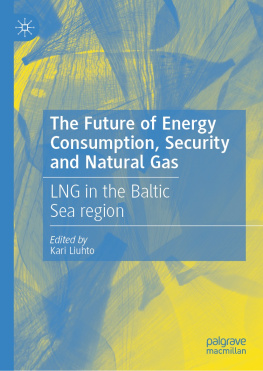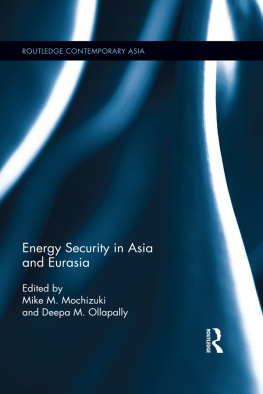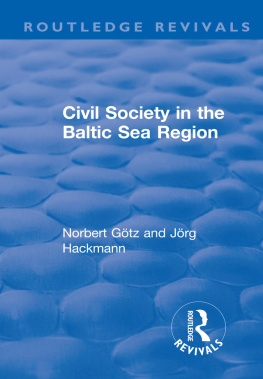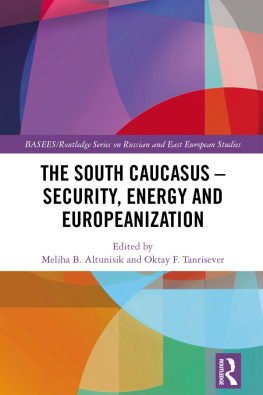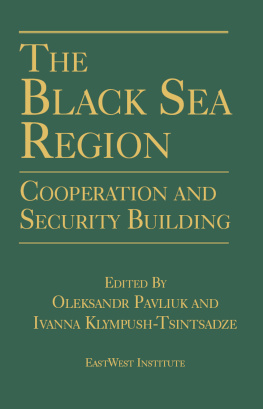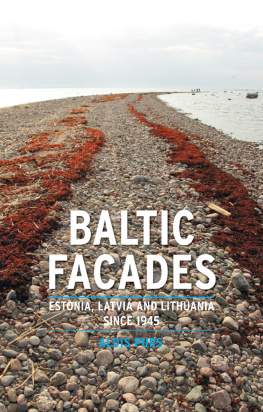The Future of Energy Consumption, Security and Natural Gas
LNG in the Baltic Sea region
1st ed. 2022

Logo of the publisher
Editor
Kari Liuhto
University of Turku, Turku, Finland
ISBN 978-3-030-80366-7 e-ISBN 978-3-030-80367-4
https://doi.org/10.1007/978-3-030-80367-4
The Editor(s) (if applicable) and The Author(s), under exclusive license to Springer Nature Switzerland AG 2022
This work is subject to copyright. All rights are solely and exclusively licensed by the Publisher, whether the whole or part of the material is concerned, specifically the rights of translation, reprinting, reuse of illustrations, recitation, broadcasting, reproduction on microfilms or in any other physical way, and transmission or information storage and retrieval, electronic adaptation, computer software, or by similar or dissimilar methodology now known or hereafter developed.
The use of general descriptive names, registered names, trademarks, service marks, etc. in this publication does not imply, even in the absence of a specific statement, that such names are exempt from the relevant protective laws and regulations and therefore free for general use.
The publisher, the authors and the editors are safe to assume that the advice and information in this book are believed to be true and accurate at the date of publication. Neither the publisher nor the authors or the editors give a warranty, expressed or implied, with respect to the material contained herein or for any errors or omissions that may have been made. The publisher remains neutral with regard to jurisdictional claims in published maps and institutional affiliations.
Cover credit: Marina Lohrbach_shutterstock.com
This Palgrave Macmillan imprint is published by the registered company Springer Nature Switzerland AG
The registered company address is: Gewerbestrasse 11, 6330 Cham, Switzerland
This book about natural gas and LNG especially in Baltic Sea region, edited by Professor Kari Liuhto, should be the basic material for politicians, civil servants, businesspeople and academia to better understand the sector and the transition. Its logic is sound, statistics collected are impressive.
Seppo Remes, Professor in Practice, Lappeenranta University of Technology, former member of the Board of Russian plastics and petrochemical giant Sibur Holding
This study is a topical and very useful presentation that opens up new perspectives for security research as well. The book deals extensively with the ongoing development and the future of natural gasespecially LNGin the Baltic Sea region. Because energy is the foundation of our modern lives, its role and development also affect regional and international security. The study provides an excellent demonstration of how economic interdependence is forcing the countries of the Baltic Sea region to tighten their partnerships. The most important message of the book is to show that energy issues are both political and economic from the point of view of comprehensive security.
Military Professor, LTC Marko Palokangas, Finlands National Defence University
Preface
Although liquefied natural gas (LNG) was already manufactured in the nineteenth century and the regular LNG exports started already 60 years ago, in international gas trade the LNG boom only started in the beginning of this millennium. As a consequence of this boom, the volume of international LNG trade has tripled in the past two decades. In fact, the LNG supply has grown faster than its consumption, which has led to the LNG oversupply and a fall in prices. Despite the current oversupply, international LNG trade is forecasted to double its current level by 2040.
The roots of this book are in the year 2015, when the Centrum Balticum Foundation ( www.centrumbalticum.org/en ) operating in Turku, Finland compiled a research brief Natural Gas Revolution and the Baltic Sea Region. This book returns to that revolution to analyse how the revolution has progressed in the Baltic Sea region. The main purpose of this book is to describe the development of natural gasparticularly LNGin the Baltic Sea region and to assess the security of energy supply linked with LNG.
This book is a collection of articles. This book begins with Mariusz Ruszels article examining the global LNG development. This Polish professor discusses in his article the way the geoeconomic factors impact the LNG exports, the way the competition between LNG exporters is turning out and the way the corona pandemic will change the global LNG market. Ruszel observes that many long-term gas contracts will expire within the next ten years. What these contracts will be replaced with has an impact on the entire European gas market. After the global perspective, the book deals with the European Union. Kari Liuhto analyses the development of natural gasparticularly LNGin the energy consumption of the European Union in this millennium. Following a detailed review, this Finnish professor addresses the energy supply risk caused by the fact that few LNG tankers are owned by EU countries. After these two introductory chapters, the analysis turns to the Baltic Sea region, the geographic focus of the book.
Leonid Grigoryev and Dzhanneta Medzhidova approach a role of LNG in the Baltic Sea countries through climate change and the EUs Green Deal. This Russian duo seeks to find out what kind of role will liquefied natural gas have in the transition from fossil fuels to renewable energy in the Baltic Sea region. The third Russian expert of the book Andrey Shadurskiy describes in detail the current state of Russian LNG export terminals and outlines the future development of the Russian LNG exports. Shadurskiy writes that Russia aims at being at least the worlds second largest LNG exporter within the next 15 years.
Mykhailo Gonchar and Igor Stukalenko examine Russian natural gas exports through pipelines. These Ukrainian experts analyse the position of the Nord Stream gas pipes, Belarus and Ukraine in the Russian gas exports to the European Union. They reveal startling historic evidence of the way the former Soviet Union strove to use natural gas and gas pipelines for its geopolitical purposes and the way the natural gas pipelines have returned to Russian foreign policy during President Vladimir Putins terms in office. Gonchar and Stukalenko also introduce a novel idea that the EU could utilise Ukraines large underground gas storages when aiming at enhancing the EUs security of supply of natural gas.
In his article, Jakub M. Godzimirski deals with the hydrocarbon reserves of Europes second largest energy exporter Norway, as well as the development of their production and exports to the European Union and Great Britain. Godzimirskis article reveals the decrease in Norways gas production in the 2030s and Norways significant role as gas supplier to Poland through Baltic Pipe. The article also points out that Norwegian natural gas may have an essential role in the production of green hydrogen. Norways relatively voluminous gas reserves, well-developed energy infrastructure and access to renewable hydropower can make Norway a dream partner for the EU in a new era of green hydrogen.

